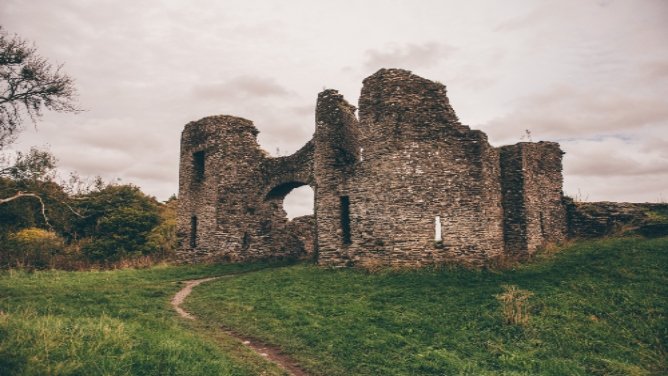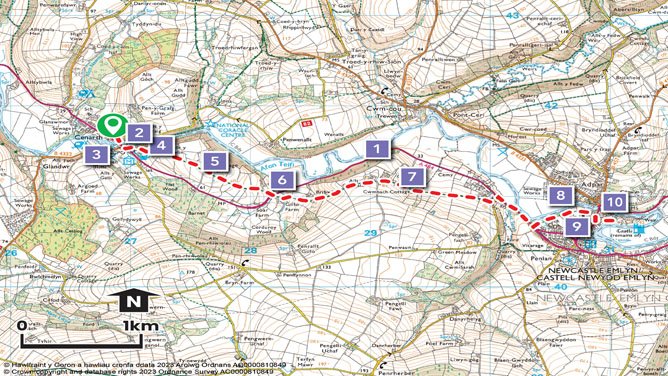This trail connects two of the Teifi valley’s most historic settlements, Cenarth and Newcastle Emlyn, passing through attractive countryside along the southern edge of the Teifi floodplain. It follows an old roadway, possibly the route followed by the army of Owain Glyndwr in June 1403 on its way to attack the castle of Newcastle Emlyn, having crossed the river near Cenarth.
Cenarth is a pretty village on the banks of the Teifi, renowned for its spectacular waterfall and salmon fishing. Giraldus Cambrensis described the salmon fishery here in 1188. The traditional coracle is still used by fishermen on the river, and
Cenarth is the home of the National Coracle Centre for Wales. Although small, the village is packed with buildings and places of great historical interest, including the parish church, which has origins going back over 1000 years, and a motte and bailey castle, built here in the 12th century to guard the river crossing.
Newcastle Emlyn owes its foundation and its name to the castle built by Maredudd ap Rhys Grug in 1240 to establish his control of the lordship of Emlyn Uwch Cych. The castle, the ruins of which can be seen on the banks of the Teifi, was involved in some of the most dramatic events in Welsh history. It was a final stronghold of the last native prince of West Wales, Rhys ap Maredudd (a son of the castle’s builder), who was executed here in 1292. In 1403, the castle was captured by Glyndwr’s men during his War of Independence. It was finally blown up by Cromwell’s forces after the end of the Civil War in 1648. Throughout those troubled centuries, the town survived and during more peaceful times grew into an important centre of local trade and commerce.
Today, Newcastle Emlyn is a busy market town with many places of interest, from shops and inns to its church, chapels, and other public buildings.
Why Walk?
This is a linear path along green lanes that link two of Carmarthenshire’s most picturesque and historically interesting villages.
Most of the route is over gently undulating ground with only a couple of short sections of moderately steep ground.
How Long? 5Km (3 miles)
How Hard? The walking is not particularly difficult, this linear route is mostly over gentle undulating ground with only a couple of short sections of moderately steep ground.
Starting point – Newcastle Emlyn
Parking – ✔
Public Transport - ✔ Newcastle Emlyn and Cenarth can be easily reached by bus from Carmarthen.
Refreshments – ✔ Newcastle Emlyn is a busy market town with many places of interest, shops, cafés and a pubs and accommodation.
Points of Interest
1. The River Teifi is important for nature conservation and designated as a Site of Special Scientific Interest. Throughout its length it changes in character forming many different habitats that support an impressive array of plants and animals , several of which are rare and endangered. Otters are widespread along the Teifi and its tributaries where vegetation provide adequate cover.
2. Giraldus Cambrensis mentioned a bridge over the Teifi in Cenarth in 1188, but the present bridge was built in 1787. The architects were William Edwards and his son David, who designed may bridges in the mid-18th century including the famous bridge in Pontypridd. The circular holes, designed to reduce the weight of the bridge, are their trademark.
3. Behind the Old Smithy, currently a heritage centre and gift shop, stand the remains of an earthwork castle. Little is known of the history of the castle but it was probably built in the 12th century to defend the river crossing. It survives today as a large earth mound on which a timber tower would have stood.
4. The current church of St Llawddog was built in 1872, after the previous church had become so ruinous that services had to be held in the schoolhouse. The crude bowl of the font dates from the 12th century or earlier. It had been used as a pig trough in Cardiganshire before being acquired by the vicar of Cenarth in the mid 19th century. In the churchyard stands a 6th century inscribed stone commemorating Curcagnus, son of Andagelli. The stone was moved for safe-keeping to the churchyard from the grounds of Gellidywyll Mansion in 1896.
5. There are three surviving buildings in and around Cenarth that have served as vicarages. This one was built in the mid-19th century. It replaced the earlier vicarage, which can be seen opposite the Three Horseshoes pub, the arch of its coach house still being visible. The most recent vicarage stands above the churchyard.
6. The trail crosses the modern A484. This road was built by the Carmarthen and Newcastle Emlyn Turnpike Trust after 1802. It ran from Newcastle Emlyn to Cenarth where it met the turnpike road connecting Cenarth to Cardigan.
7. Gelligatti was a farmstead at the centre of the hamlet of Gelligatti, one of four hamlets in Cenarth parish. In 1670 the house was assessed for tax purposes as having four hearths, making it one of the most important houses in the area. The current farmhouse and its impressive outbuildings were built in the mid-19th century.
8. Glimpses of Adpar on the far side of the Teifi can be seen. Adpar was a borough town owned by the Bishop of St David’s in medieval times. Little remains of this settlement, only the motte castle that stands in a commanding position overlooking the bridge between Newcastle Emlyn and Adpar.
9. Canada Geese can often be seen grazing the meadows opposite the castle. By day, during the summer months, Sand Martins and Swallows hunt insects over the river. These are replaced at dusk by bats.

